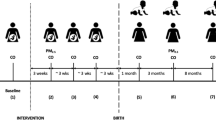Abstract
Indoor air pollution (IAP) from cooking and heating stoves is a major cause of acute respiratory infections (ARI) and a serious health risk in developing countries. This paper examines improvements in respiratory health for children five and under in rural China resulting from stove and behavioural interventions to reduce IAP. The analysis uses data from a World Bank/Government of China project completed in 2006, whereby a large number of rural households from four provinces in China were subject to different combinations of stove improvement and behavioural interventions to reduce IAP levels and exposure. Difference-in-difference and matching models show that both stove and behavioural interventions were effective in reducing the incidence of ARI, although the latter are more cost effective.
Similar content being viewed by others
References
Abadie A, Drukker D, Herr JL, Imbens G (2001) Implementing matching estimators for average treatment effects in STATA. STATA J 1: 1–18
Abadie A, Imbens G (2006) Large sample properties of matching estimators for average treatment effects. Econometrica 74(1): 235–267
Bruce N et al (2007) Pneumonia case-finding in the RESPIRE Guatemala indoor air pollution trial: standardizing methods for resource-poor settings. Bull World Health Organ 85: 535–544
Duflo E, Greenstone M, Hanna R (2008) Indoor air pollution, health, and economic well-being. Surv Perspect Integr Environ Soc 1(1)
Ezzati M, Baris E (2007) Household energy and health in rural china: lessons and potentials for program design. World Bank
Fitzgerald J, Gottschalk P, Moffitt R (1998) An analysis of sample attrition in panel data: The Michigan panel study of income dynamics. J Hum Resour 33(2): 251–300
Homedes N (1996) The disability-adjusted life year (DALY). Definition, measurement and potential use. World Bank. Human capital development working paper 68
Imbens (2010) Lecture notes 1, unconfounded treatment assignment. IEN, Miami
Lanata C, Rudan I, Boschi-Pinto C, Tomaskovic L, Cherian T, Weber M, Campbell M (2004) Methodological and quality issues in ALRI studies in children in developing countries. Int J Epidemiol 33(6): 1362–1372
Pitt MM, Rosenzweig MR, Hassan MN (2006) Sharing the burden of disease: Gender, the household division of labor and the health effects of indoor air pollution in Bangladesh and India, Mimeo, Yale University
Rudan I, Tomaskovic L, Boschi-Pinto C, Campbell (2004) Global estimate of the incidence of clinical pneumonia among children under five years of age. Bull World Health Organ 82(12)
Smith KR (1999) Indoor air pollution. Pollution management in focus. World Bank 8(4)
Smith KR, Mehta S, Maeusezahl-Feuz M (2004) Indoor air pollution from household use of solid fuels (Chapter 18). In: Majid E (ed) Comparative quantification of health risks: global and regional burden of disease attributable to selected major risk factors, World Health Organization
Strauss J, Thomas D (1998) Health, nutrition, and economic development. J Econ Lit 36(2): 766–817
U.S. EPA. (1996) Air quality criteria for particulate matter. EPA/600/P-95/001cF. Washington, DC: U.S. Environmental Protection Agency
Wooldridge J (2002) Inverse probability weighted M-estimators for sample selection, attrition, and stratification. Portuguese Econ J 1(2): 117–139
World Health Organization (2005) Handbook: integrated management of childhood illness
Zhou Z et al (2006) Community effectiveness of stove and health education interventions for reducing exposure to indoor air pollution from solid fuels in four Chinese provinces. Environ Res Lett 1: 014010
Author information
Authors and Affiliations
Corresponding author
Rights and permissions
About this article
Cite this article
Yu, F. Indoor Air Pollution and Children’s Health: Net Benefits from Stove and Behavioral Interventions in Rural China. Environ Resource Econ 50, 495–514 (2011). https://doi.org/10.1007/s10640-011-9479-5
Accepted:
Published:
Issue Date:
DOI: https://doi.org/10.1007/s10640-011-9479-5




